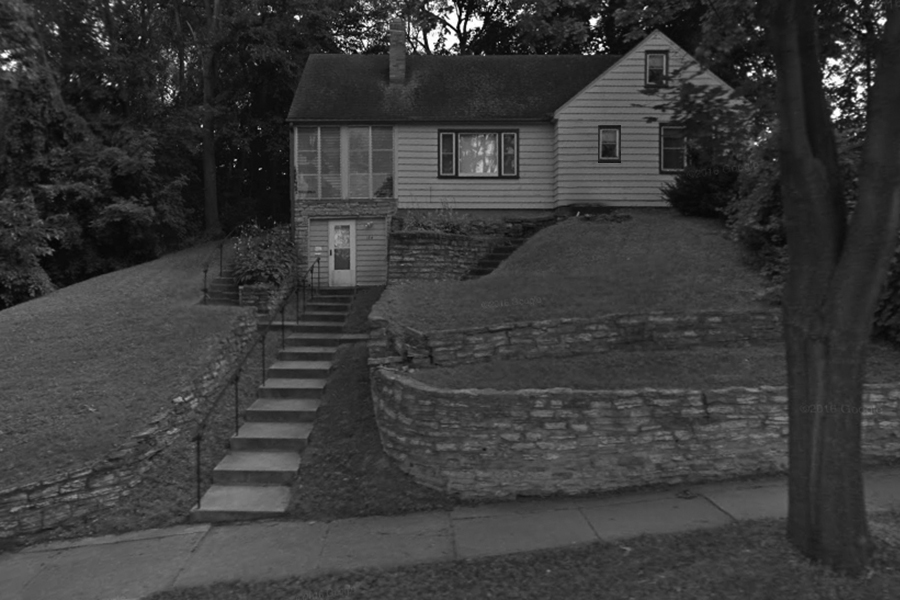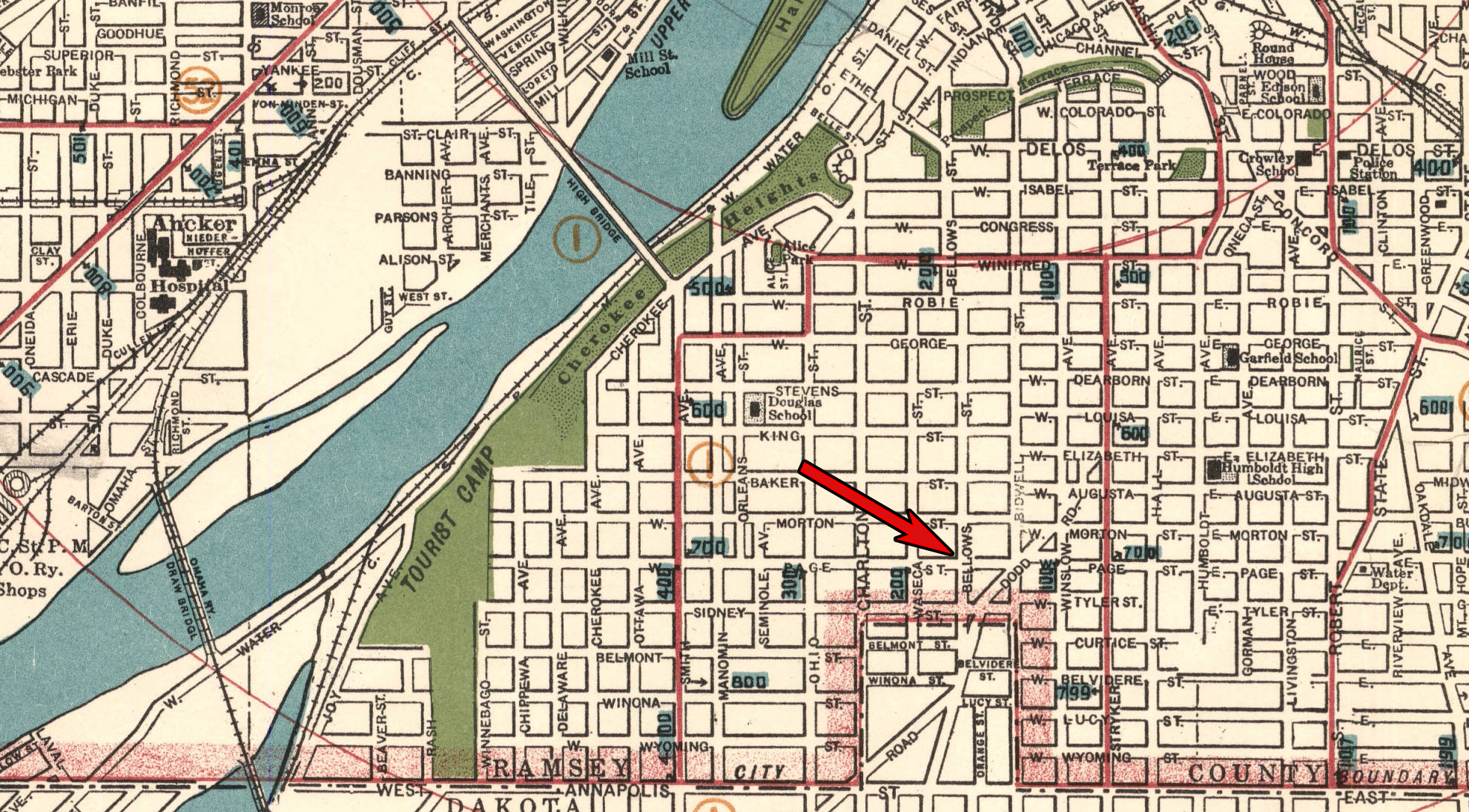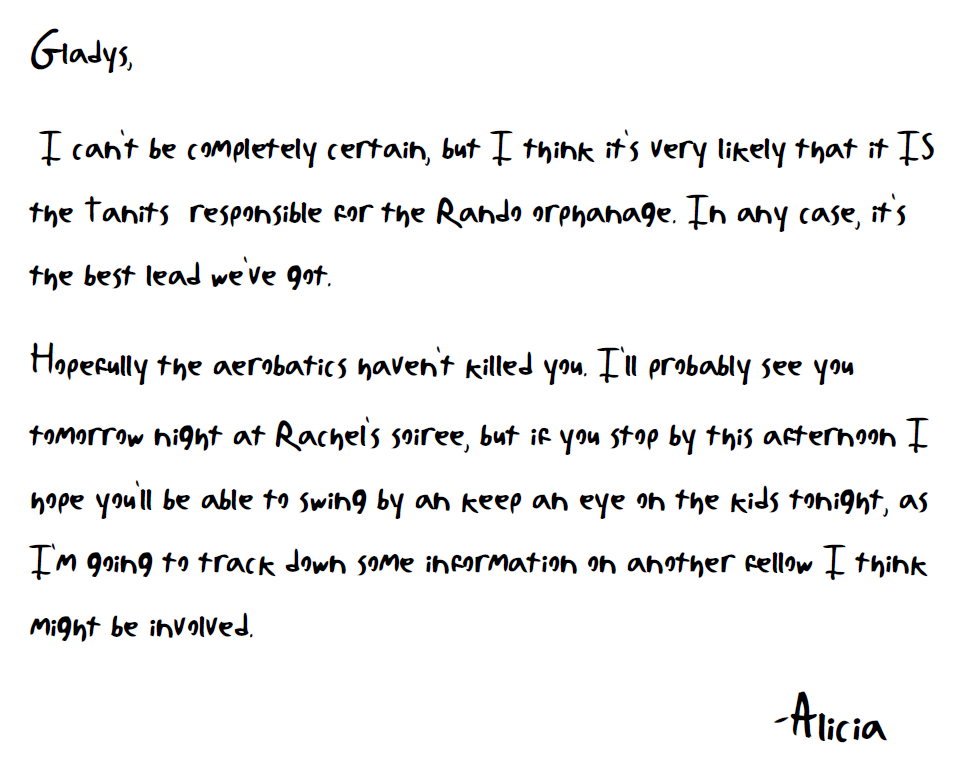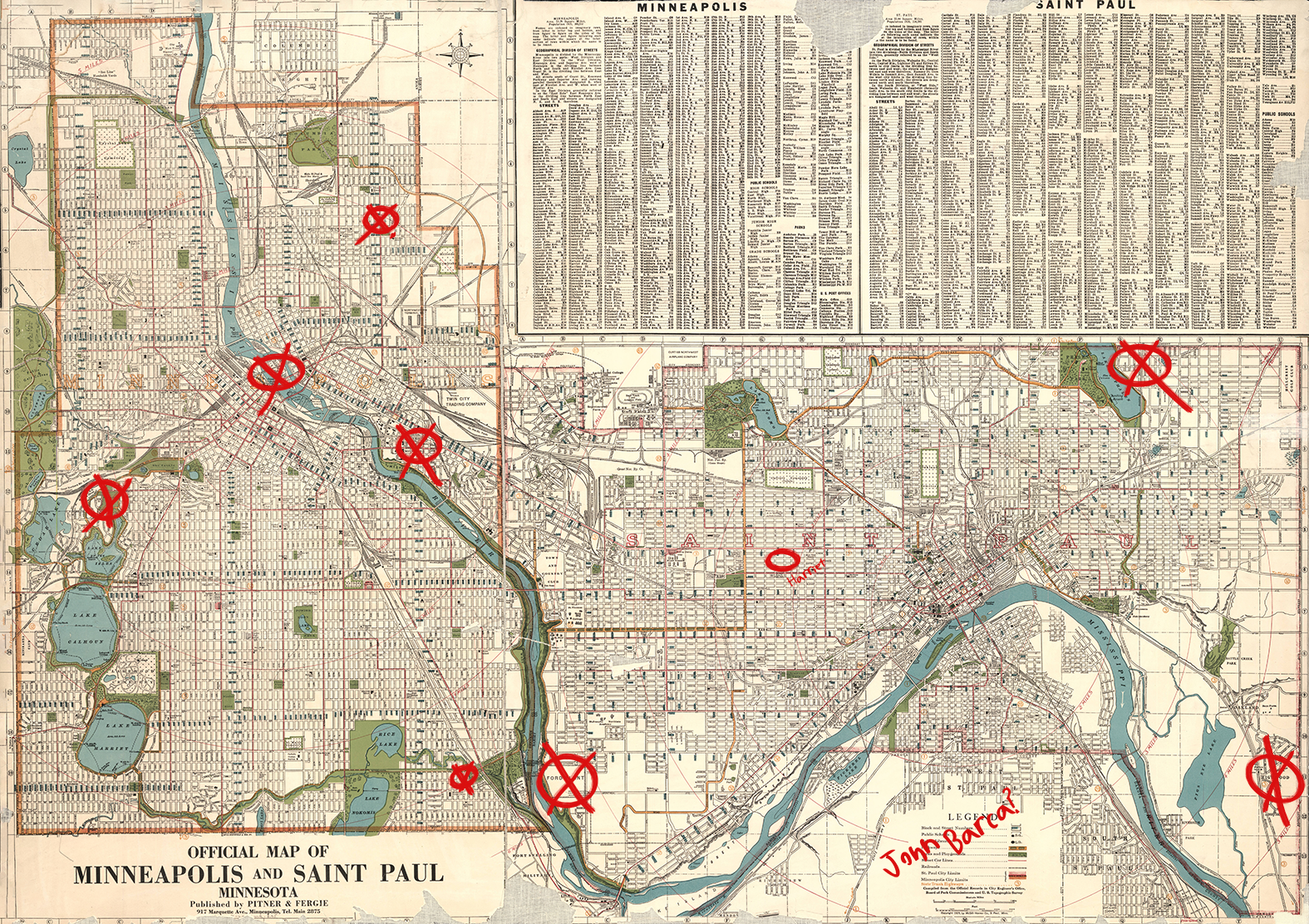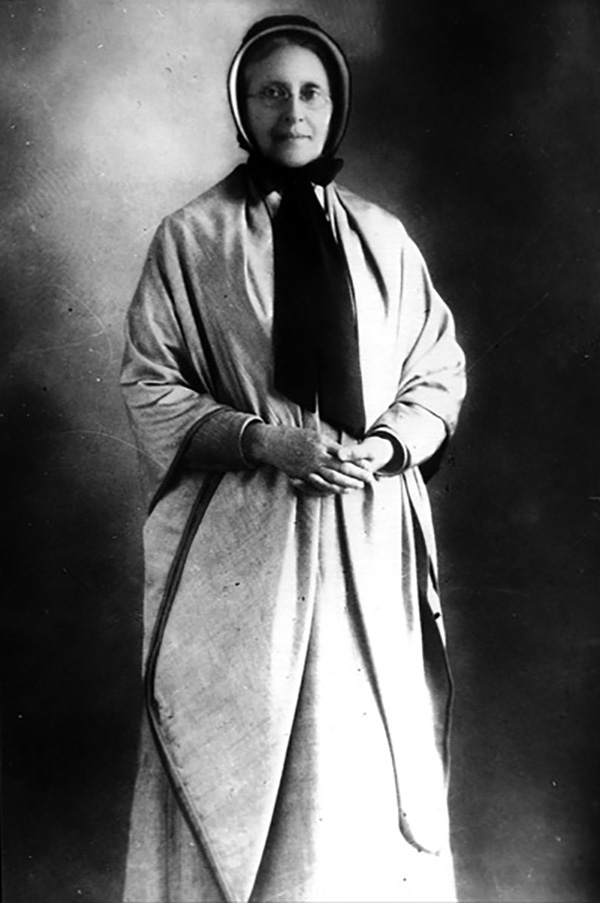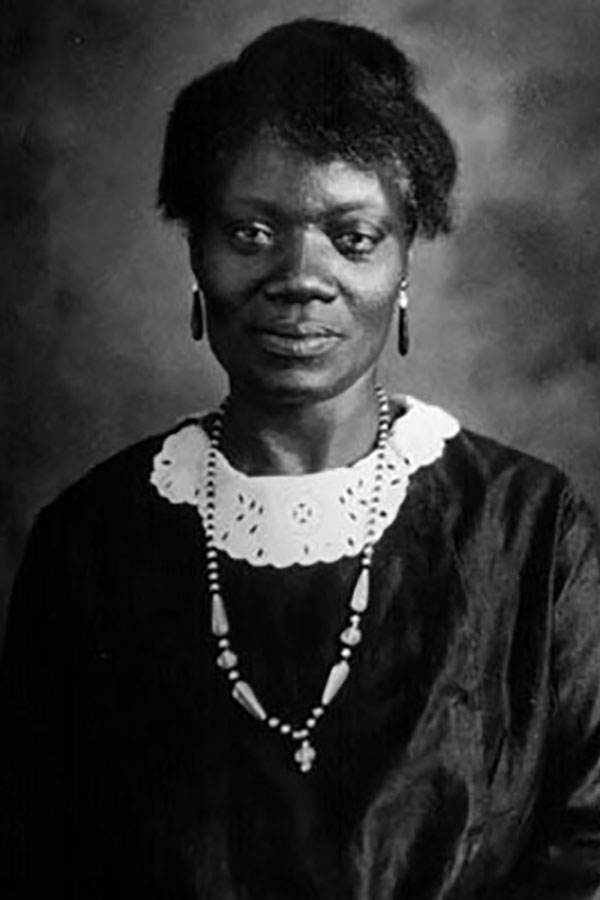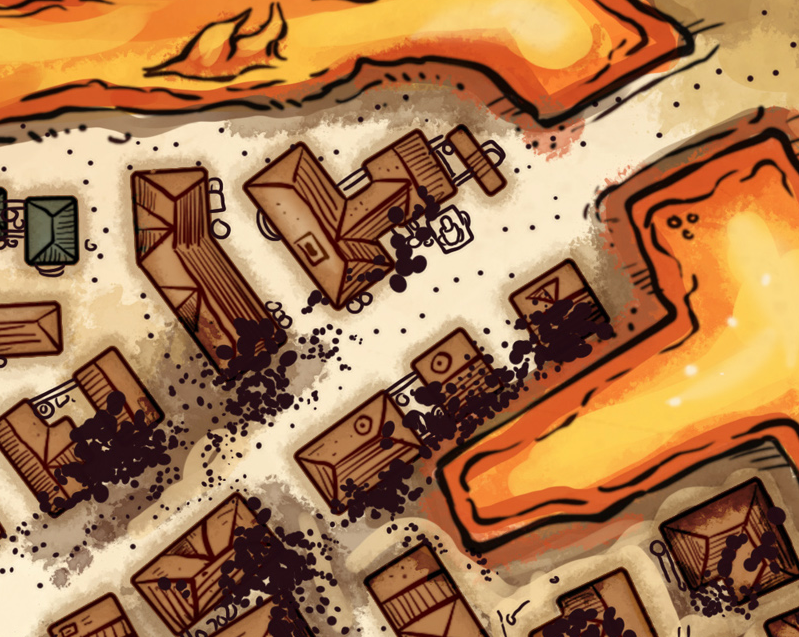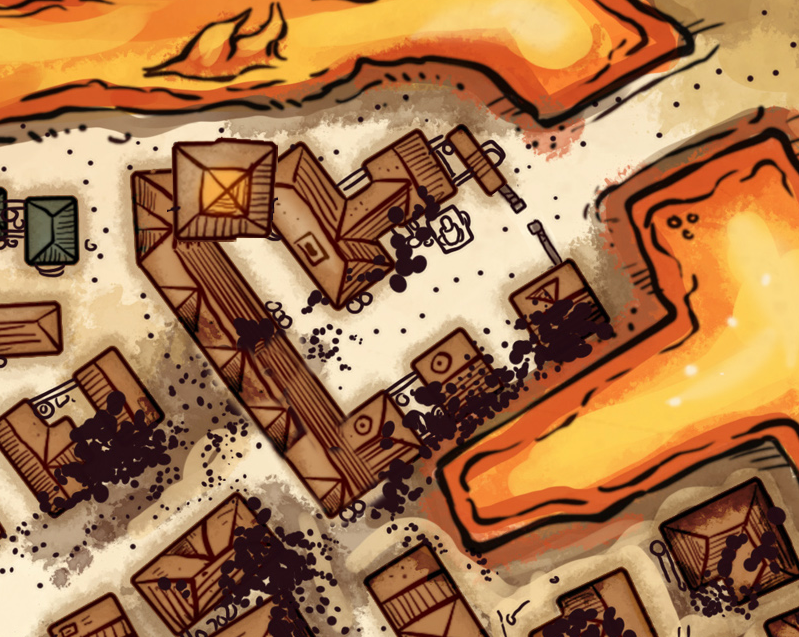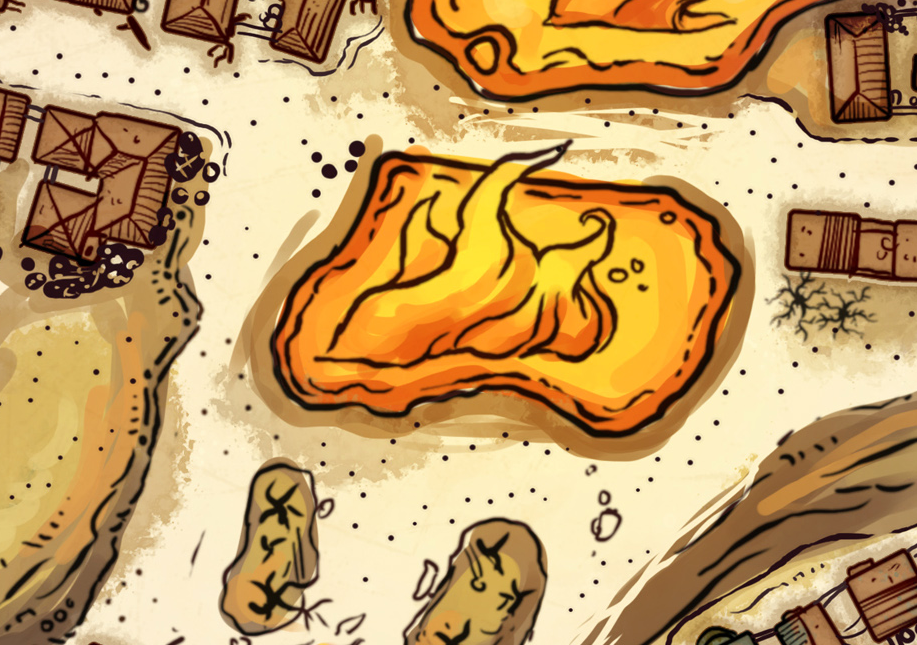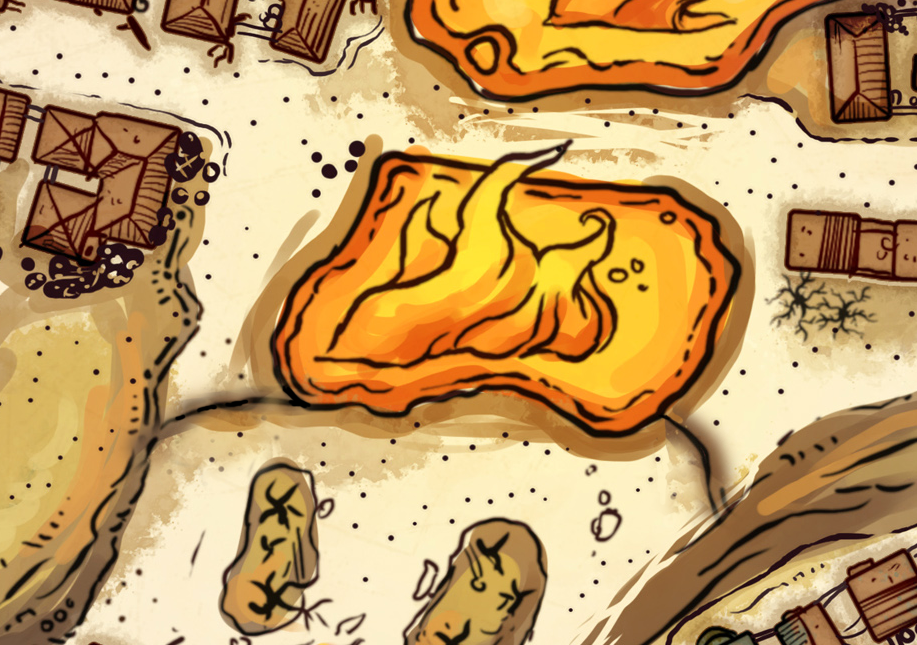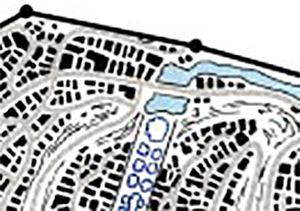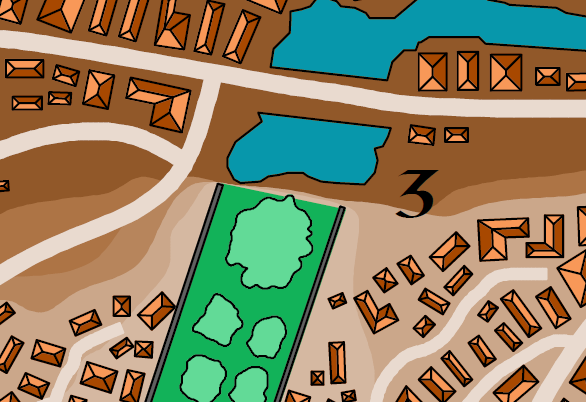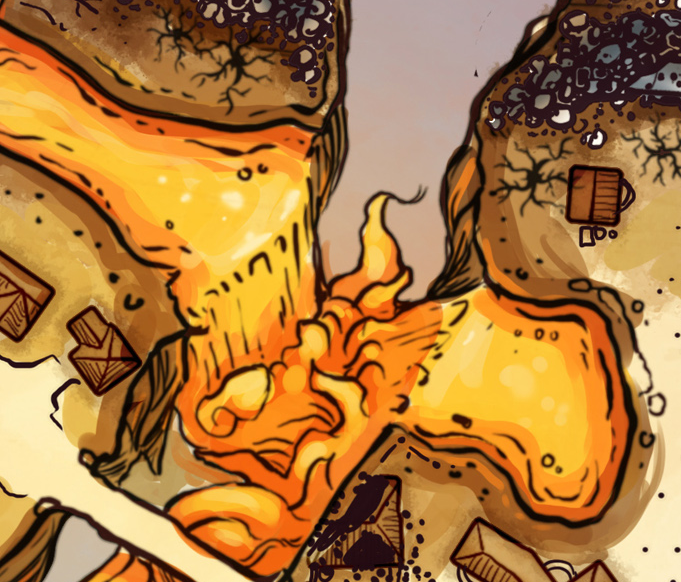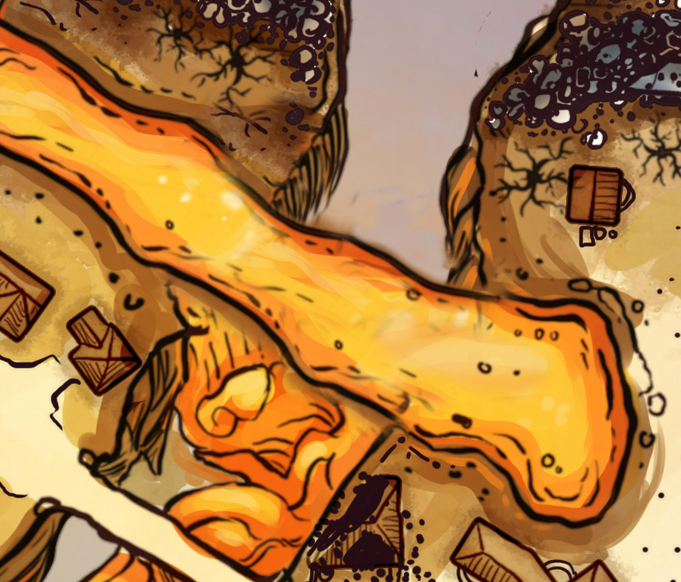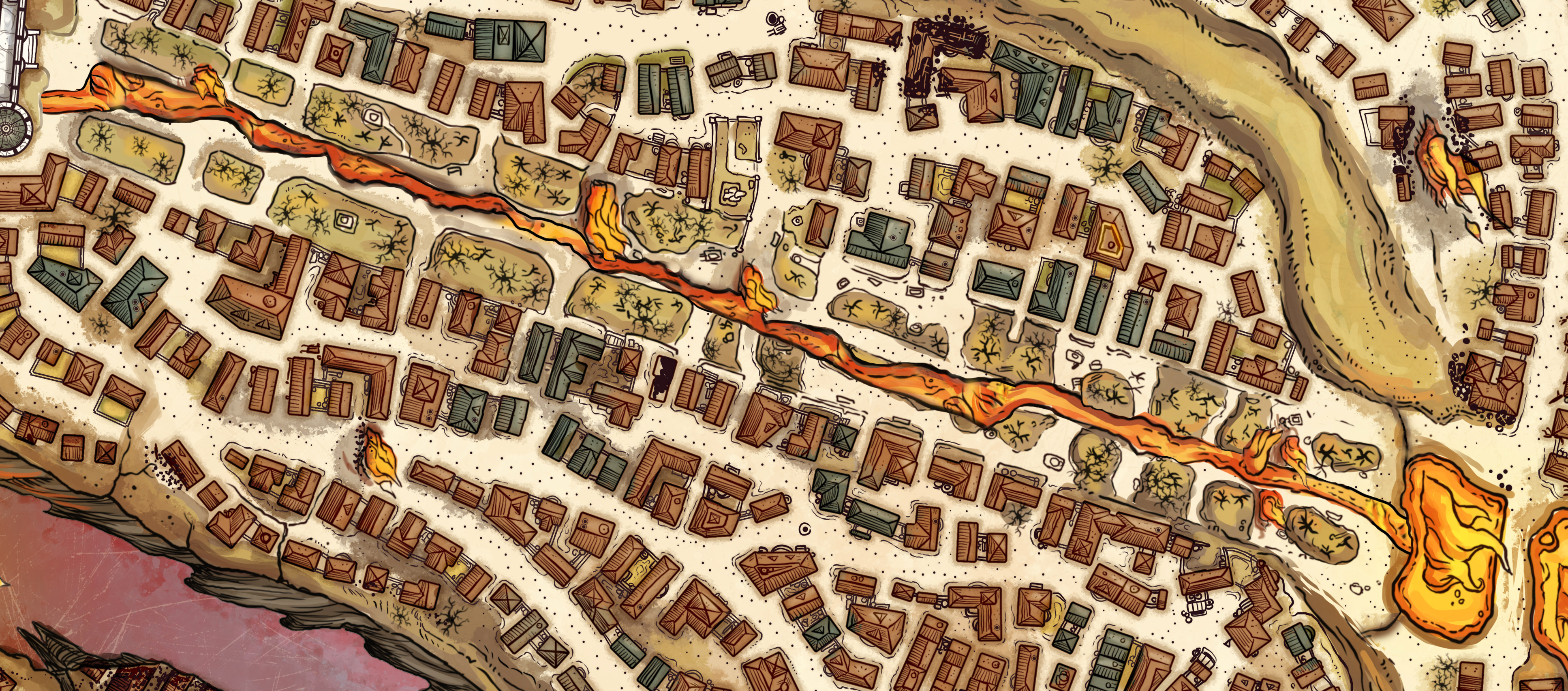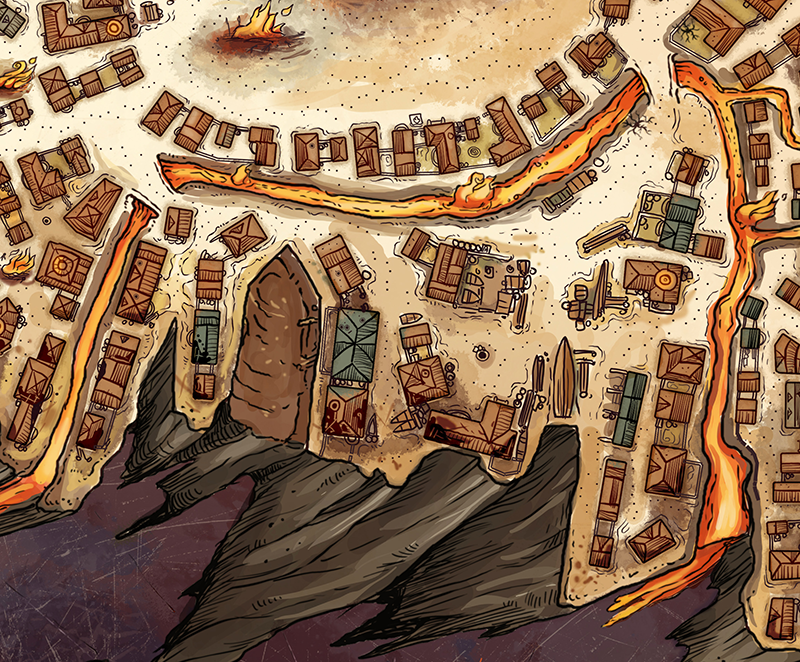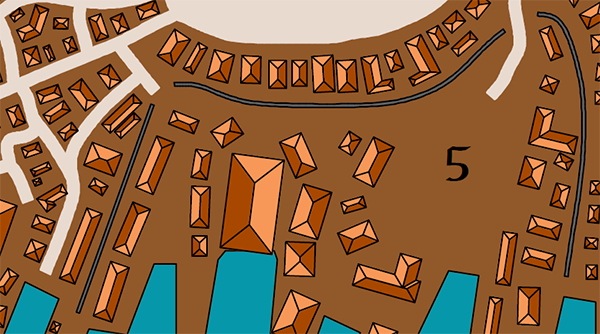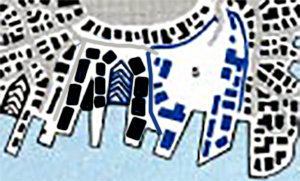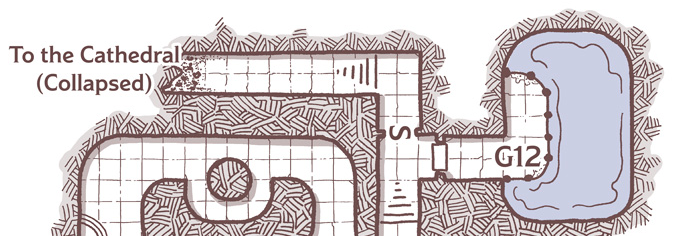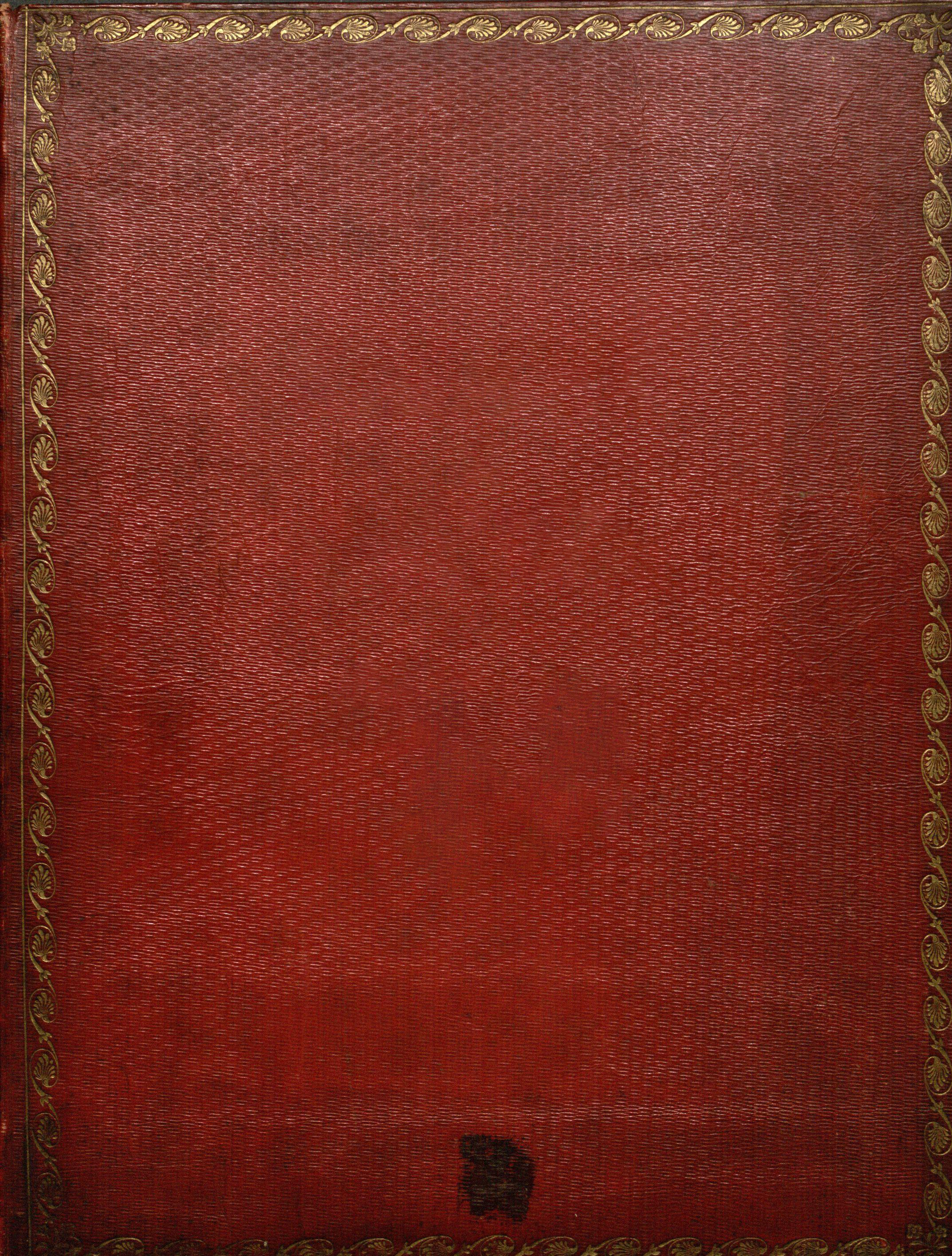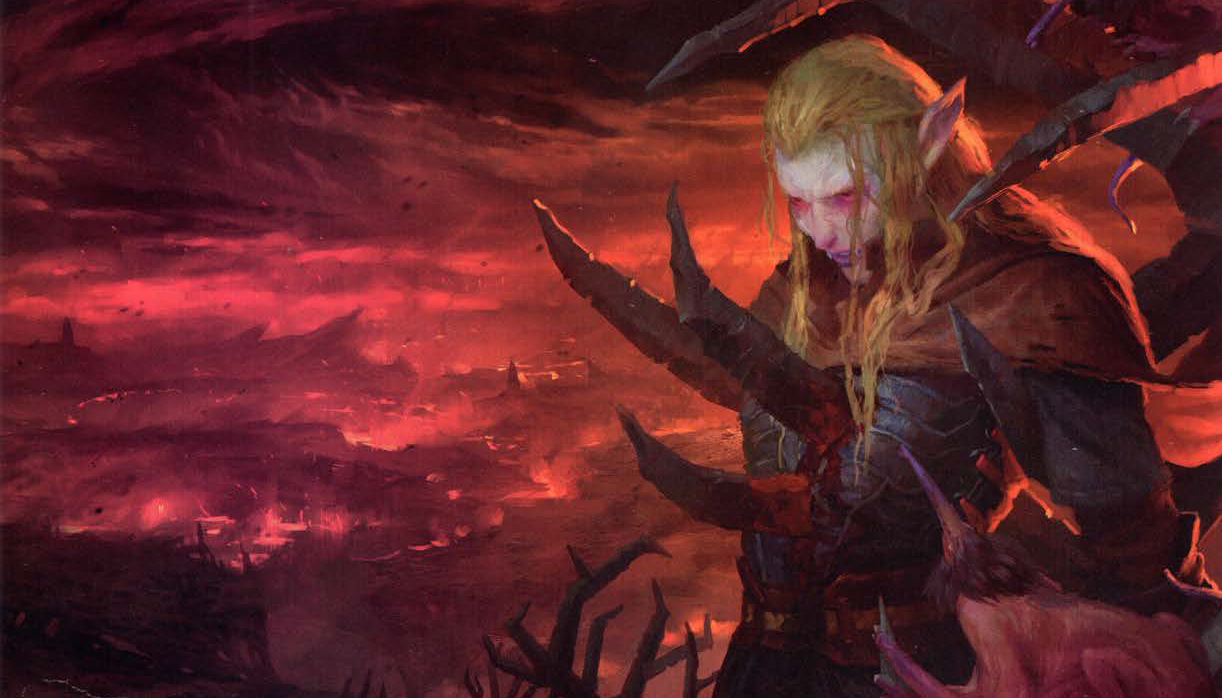
Go to Table of Contents
As the PCs leave Elturel, I think the time has come to take a step back and look at the big picture: They’re in Avernus now. So what are they trying to do, exactly?
This post takes a close look at how the adventure is currently structured (and the problems I have with that structure). Then the rest of Part 6 is going to present the big picture of how we’re going to remix this structure. We’ll want this big picture to get us oriented in Part 7: Exploring Avernus and keep us pointed in the right direction as we wrap things up in Part 8: The End.
QUICK SUMMARY: THE ORIGINAL CAMPAIGN
- The PCs indirectly get a vision from Torm which reveals that (a) Lulu helped hide the Sword of Zariel before she lost her memories and (b) she talked to a couple of kenku at some point after doing so. (The NPCs are all convinced the Sword of Zariel will save Elturel, although it is not explained how or why.)
- Lulu remembers that she met the kenku at Fort Knucklebones, so the PCs go there.
- Lulu remembers that the Sword of Zariel was at Haruman’s Hill, so the PCs go there. (It isn’t.)
- Lulu remembers two other locations that will lead to the Sword of Zariel, so the PCs choose one of them and go there.
- Each location is the starting point of a different linear railroad. If the PCs follow the railroad they’ve selected, they eventually get the Sword of Zariel.
THE PROBLEM WITH LULU’S MEMORIES
As you can see above, recovering/following Lulu’s memories is the key to the entire adventure.
When the PCs first meet Lulu and she starts tagging along with them, we’re given the back story of what actually happened (DIA, p. 51) and a little table of random memories that she can intermittently recover during the adventure. This is clever, giving the DM a simple tool for keeping this central theme/plot gimmick consistently in focus as the campaign progresses.
 Having made Lulu’s memories the central plot gimmick of Descent Into Avernus, however, you might conclude that the designers would make sure that her back story is crystal clear to the DM, ensuring that this absolutely vital continuity is easily handled without error.
Having made Lulu’s memories the central plot gimmick of Descent Into Avernus, however, you might conclude that the designers would make sure that her back story is crystal clear to the DM, ensuring that this absolutely vital continuity is easily handled without error.
You would be wrong.
In fact, Lulu’s back story doesn’t even make sense. For example, the vision from Torm says, “The elephant knows! After hiding the Sword she met some kenku!” And Lulu says: “I remember! The kenku live at Fort Knucklebones! Let’s go!”
But:
- If you flip back to the summary of Lulu’s story (DIA, p. 51), neither the kenku nor Fort Knucklebones appears. This is an egregious oversight. However, you can eventually conclude that her visit there MUST have happened when “Lulu wandered Avernus for months” after Zariel’s fall.
- Those kenku, although still alive, should definitely be dead. Zariel’s fall happened in 1354 DR and Lulu “wandered Avernus for months.” That means she met the kenku 140 years ago. Kenku only live for 60 years.
- The kenku are at Fort Knucklebones because they work for Mad Maggie. But when Mad Maggie first came to Avernus (and before going to Knucklebones), “she “found pieces of a beautiful tapestry that chronicled the fall of Zariel.”
So within a few months of Zariel’s fall:
- Someone made a tapestry;
- The tapestry was ripped to shreds;
- Mad Maggie found the tapestry;
- Mad Maggie founded Fort Knucklebones; and then
- Lulu came to Fort Knucklebones (meeting some kenku who are, I guess, immortal).
You can kind of shuffle things around so that this makes sense (change it so that Maggie didn’t find the tapestry and become interested in Zariel lore until recently, long after founding Fort Knucklebones; which also explains why she didn’t pump Lulu for all the information she knows about Zariel the FIRST time she met Lulu), but it’s still a massive continuity glitch sitting right in the middle of a crucial scenario hook in the middle of the campaign.
And this is just one example! Lulu’s timeline is filled with contradictions and inconsistencies!
Descent Into Avernus positions this as THE central mystery of the campaign, but then it basically doesn’t have a coherent solution to the mystery. It’s like a murder mystery that can’t quite make up its mind about who committed the murder.
DIA: You MUST figure this out!
Players: Yes! We NEED to find the answers to this!
DIA: Find the answers to what now?
We’ll be sorting this out in Part 6D: Lulu’s Memories.
THE KENKU PROBLEM
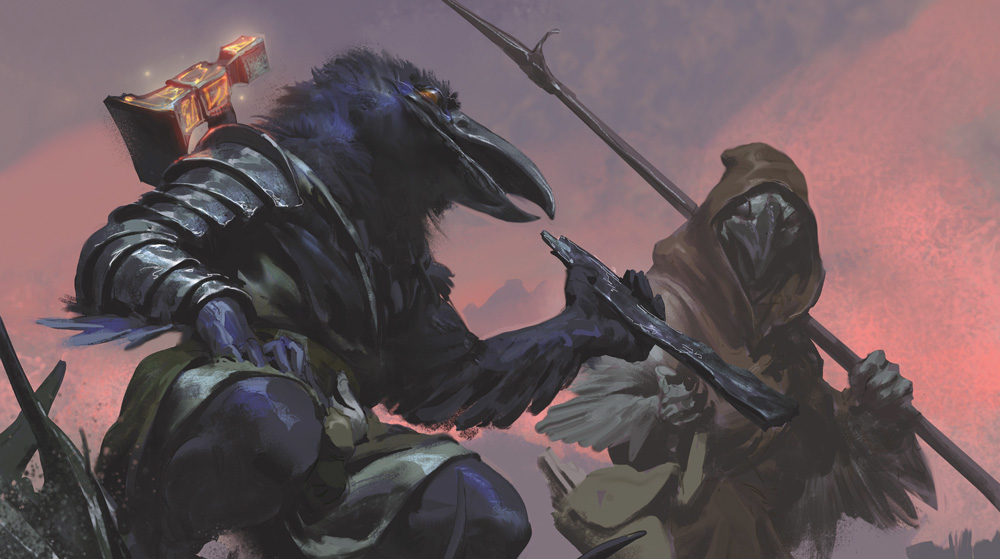
Remember those kenku?
Descent Into Avernus says, “Find the kenku! They knew Lulu back in Ye Olde Days! They’ll have valuable information that will help you to find the Sword!”
So the PCs go to Fort Knucklebones. They find the kenku. The adventure says, “The kenku Chukka and Clonk instantly recognize Lulu, since they’ve met her previously.” And then… nothing.
Literally nothing.
The kenku remembering Lulu is, as far as I can tell, never mentioned again. And if the players decide to push the issue and try to get the valuable information they were promised, there’s absolutely nothing for the DM to give them.
This isn’t just a dead end either: Remember that the kenku DO remember Lulu. Even if they don’t have any vital information, there’s still a story to be told here — a lost fragment of Lulu’s memories to recover in a scenario which has been explicitly positioned as being about recovering Lulu’s memories. It’s not that Descent Into Avernus says “nothing to find here”; it’s that Descent Into Avernus just completely forgets the reason the PCs came to Fort Knucklebones.
It was almost incomprehensible to me that such an egregious oversight could have made it into print… until I took a step back and tried to understand the designers’ mental paradigm.
What we are, in fact, talking about here is the scenario structure. I’ve talked in the past about the fact that D&D (and RPGs in general) do a pretty terrible job of teaching scenario structures to new DMs. In fact, they’ve historically only taught one (dungeoncrawling), and in 5th Edition they’ve even failed to do that. (5th Edition notably doesn’t teach a new DM how to key a map — or even provide an example of a keyed map! — let alone teach them how to use it in play.)
Without primary sources, new DMs are largely learning their scenario structures from published examples. But it’s been decades now and the communal knowledgebase is atrophying. It’s gotten so bad that even a lot of professional designers don’t know how scenarios are supposed to be structured, so even the published examples that DMs used to be able to learn from are degenerating.
Which brings us to Descent Into Avernus: The designers don’t actually have a functional scenario structure. They’ve instead flailed themselves into a sort of malformed scenario structure which consists entirely of:
- An NPC tells the PCs where to go.
- The PCs go there.
The entire campaign is just this one “structure” repeated infinitely: An NPC tells you where to go. You go there and you find another NPC who tells you where to go.
So when it comes to the kenku, the designers aren’t designing a situation; they aren’t thinking of the game world as a real place. They aren’t even thinking about what the players’ actual experience will be (what they’ll be thinking, what they’ll want, etc.). They’re thinking of the kenku strictly as another McGuffin in a long string of McGuffins: They needed a mechanism to move the PCs from Elturel to Fort Knucklebones. The kenku were that device. The PCs are now at the Fort. Therefore, the kenku are done.
And, thus, the kenku are immediately dropped.
Furthermore, because this malformed structure is apparently ALL THEY HAVE, it seems to have become a kind of cargo cult for them: They know that NPC A has to give some sort of “explanation” for why the PCs need to go to NPC B, but they frankly don’t care what the explanation is.
And they assume the players won’t care either. The presumption is that the players are onboard; that the players share their understanding that “the NPC tells me where to go and then I go there” is the one and only way that things work.
The designers expect that players to immediately transition to the “make Mad Maggie happy” mini-game they’ve designed without ever questioning the kenku about the thing they came here to question the kenku about because they literally never gave a shit about the ostensible reason the PCs were looking for the kenku.
I call this the Kenku Problem. And once you’ve seen it, you really can’t unsee it. It explains A LOT of the problems Descent Into Avernus has:
- Why do they keep putting Must Have Encounters™ behind secret doors? Because if the PCs haven’t found the NPC to tell them where to go next, clearly the players will know to keep looking until they find them!
- Why are the PCs told to go talk to people without being given any reason for doing so? Because the REASON is irrelevant. It’s white noise surrounding the operative phrase of “go talk to <insert name>.”
- Why are the PCs told what will be inside the puzzlebox by the same guy who tells them to “go talk to <insert name> to have the puzzlebox opened” (thus murdering the pay-off for doing so)? Because they don’t care about the mystery and they don’t think you’ll care either. The only reason the “mystery” exists is so that you’ll go talk to <insert name>.
- Why does the adventure assume the PCs will simply plane shift to Hell without having any reason to do so? Because an NPC told them to! (Why not have the NPC give them a coherent reason? Because it doesn’t matter!)
This superficially makes it seem as if the NPCs are all-important! But, ironically, they’re not. They’re just cogs in the machine; their sole function to point you to the next cog. This is why the adventure doesn’t care enough about Kreeg’s history to make it consistent. Nor Zariel’s. Nor Lulu’s. Nor Ravengard’s. Nor the kenku. Nor… well, anybody.
Ravengard tells you to talk to the kenku. The kenku tell you to talk to Mad Maggie.
Nothing else matters.
Note: There are twenty-nine (!) writers credited in Descent Into Avernus. It is quite plausible that when I’m ascribing creative decisions to the “designers” here what I’m actually doing is anthropomorphizing artifacts from whatever development process was used to create and stitch together all of those contributions. By the same token, the book still managed to get to press without anybody saying, “Hey… What do those kenku know about Lulu? Isn’t that the whole reason the PCs came here?” And it won’t stop a DM from getting wrong-footed by the adventure-as-written in actual play.
THE KNUCKLEBONES PROBLEM
Fort Knucklebones itself suffers from a common problem I see in adventure design: Interstitial content that’s not supported by the main line of activity.
The fort is filled with encounters that all start with some variation of, “While the PCs are here…”
- “At some point during their visit, the characters see the kenku…”
- “Characters who witness this can…”
- “As events play out in Fort Knucklebone, the characters notice…”
And so forth.
There’s absolutely nothing wrong with interstitial content: The world should not be strictly reactive (the PCs do something and the world reacts); it should also be proactive (stuff happens in the world and the PCs can react to it).
But for interstitial content to work, there MUST be enough stuff for the PCs to actively engage with so that there’s enough time for the interstitial encounters to be triggered. And this is not the case here. Instead, as soon as the PCs enter Fort Knucklebones this happens:
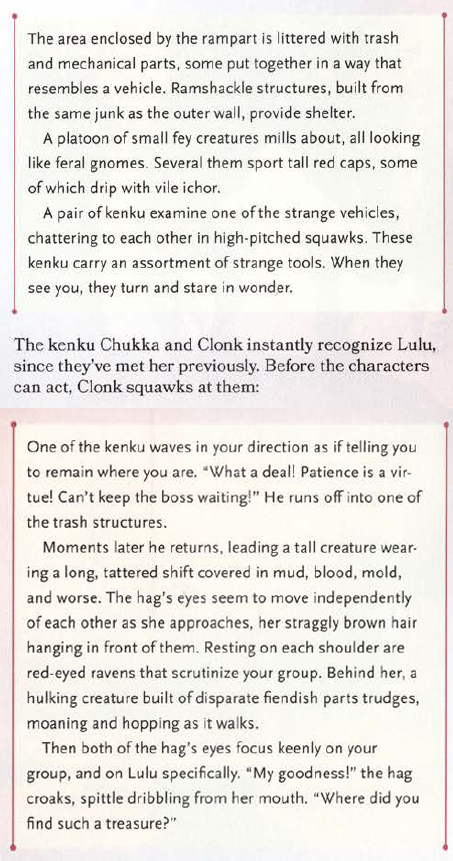
They immediately meet Mad Maggie. They tell her what they want. She immediately takes them to a dream machine and recovers Lulu’s memories. Lulu immediately declares she knows where the Sword is. The PCs will then immediately leave. (Why wouldn’t they?)
No narrative space is given for the PCs to just hang out at Fort Knucklebone, which means that all of the “hanging out at Fort Knucklebone” encounters will never happen.
It’s possible that the fort was originally intended to be some sort of hub or home base for the PCs so that these interstitial encounters would play out over the course of several visits, but as written it isn’t. In any case, the encounters as written are supposed to play out before Maggie gives them supplies (because their outcome is supposed to influence that), even though there’s a continual stream of uninterrupted interaction with Maggie from the moment they enter the base until she gives them the supplies.
You can kind of half-ass a solution by simply injecting extra time into the main line of Maggie’s activities. For example:
- Instead of immediately meeting the kenku and having them immediately bring Maggie to the PCs, the PCs have to find the kenku and then go to Maggie (so that they explore the fort a bit and meet some of the people there before meeting her).
- It will take Maggie some time to assemble the dream machine. Probably a few hours should suffice, during which time the PCs can do all the other things.
If you want to full-ass a solution, though, you’ll want to figure out some sort of active agenda the PCs could be pursuing at the fort while waiting for Maggie to finish the machine. Otherwise they’re just twiddling their thumbs. Instead of Maggie automatically giving them supplies, for example, maybe they need to get properly outfitted for Avernus here.
As described in Part 6C: Quest of the Dream Machine, the Remix will, in fact, make Fort Knucklebones a de facto hub that the PCs are likely to make their homebase and return to multiple times.
THE CHOOSE YOUR RAILROAD PROBLEM
Let’s be blunt: Choose Your Railroad is a terrible scenario structure.
It’s almost an oxymoron. You recognize that choice is important, but then you immediately discard it in favor of a long string of Kenku Problem interactions lightly spiced with meaningless fetch quests.
(A quick digression on fetch quests: A fetch quest is any time an NPC tells a PC to get a Plot Coupon and return it to them; or, vice versa, when the NPC gives the PC a Plot Coupon and tells them to take it some place else. A meaningful fetch quest is one where the PCs care about the Plot Coupon and its disposition. A meaningless fetch quest is one where only the NPC cares about the Plot Coupon and the only reason the PCs are delivering it is because they want the NPC to do something else for them; as a result, the actual Plot Coupon and what you’re doing with it is inconsequential and could easily be swapped out for any other arbitrary items/locations.)
This is very much a variation of the broken Choose Your Own Adventure design technique, and it’s particularly painful here because Descent Into Avernus actually promises to deliver this incredible, open-ended exploration of Avernus before yanking it away.
But the problems with the adventure’s Choose Your Railroad go much deeper than the fact that it’s just a bad idea in principle. It’s actually difficult to explain how poorly this is done.
So the PCs have Mad Maggie use her dream machine on Lulu. Lulu wakes up and says, “The sword! The sword! I know where it is!”
(Spoilers: She doesn’t.)
Her “dreams lead the characters on a wild goose chase to Haruman’s Hill.”
First: There’s no clear reason given for why Lulu thinks Haruman’s Hill is where the sword is.
Second: Given the timeline, it’s fairly clear that Haruman’s Hill did not and could not exist when Lulu was in Avernus.
But, OK. Fine. This thing that makes no sense happens. The PCs go adventuring at Haruman’s Hill for a little while, they figure out that Lulu took them to the wrong place, and Lulu says:
“I’m so sorry! My memory is a little hazier than I thought! Having pondered my dreams further, I think there are two sites in Avernus that are important to finding the sword! Choose between a place where demons manifest and one where demons are destroyed.”
These are, of course, the two railroads.
But, once again, there’s no reason given for why Lulu thinks either of these locations have anything to do with the Sword.
And that’s because they don’t.
They have nothing to do with the Sword. They have nothing to do with Lulu’s memories.
THERE IS NO REASON FOR LULU TO SAY YOU SHOULD GO TO THESE TWO LOCATIONS.
And this becomes abundantly clear as soon as the PCs go to them.
The first one is a harvesting station for abyssal chickens. Four (presumably redneck) devils are harvesting the chickens and bullying another devil who is mentally impaired. These guys explicitly know absolutely nothing about what the PCs are trying to do, but if the PCs bribe them they can tell them where to find a guy who MIGHT know something that can help them.
Okay. What about the other location?
Here the PCs meet a devil who knows absolutely nothing about what they’re trying to do, but if they go on a meaningless fetch quest for him he’ll give them a letter of introduction to another guy who MIGHT help them do a thing that they’re NOT doing.
So to briefly recap here:
- Lulu takes you to the wrong location.
- Lulu tells you two more locations to go to, but can give no reason why you should.
- If you go to those locations, it is immediately clear that there’s no coherent reason for you to be there.
So Lulu:
- Demonstrates she can’t be trusted to give accurate directions.
- Fails to give accurate directions AGAIN.
- Descent Into Avernus than assumes the PCs will just continue along the “Path” they’ve “chosen,” even though there’s no discernible reason for them to do so.
And obviously this is a “reasonable” assumption because there are, after all, NPCs telling the PCs where to go and this is a Kenku Problem.
Fixing this was non-trivial. I wasn’t sure there WAS a fix without starting over from scratch, because the adventure had really backed itself into a corner here.
If I hadn’t solved it, of course, then we wouldn’t be doing this Remix at all.
The actual railroads themselves are filled with a plethora of problems (as railroads always are), but since we’re defenestrating the whole structure there’s not a lot of value in breaking it down point by point. Our alternative structure will be laid out in Part 6C: Quest of the Dream Machine, and Part 7: Exploring Avernus will look at how to run Avernus as a true exploration campaign.
Go to Part 6B: The Avernian Quest
